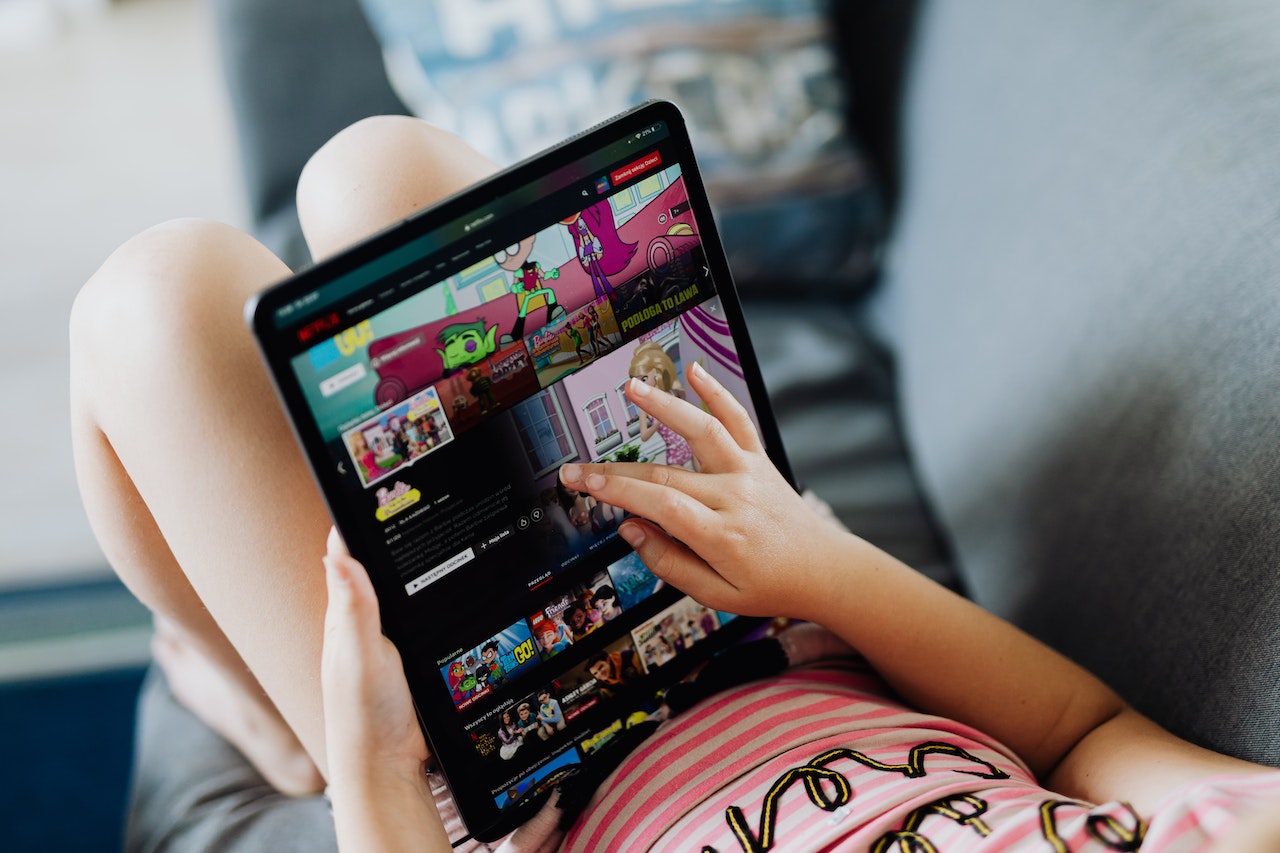Did you know the average Aussie now spends 10.8 years of our life on our phone? Yep – and while some of that is time well spent, for sure (like texting a mate on their birthday, or reading epic content like this here article) - we all know how quickly a quick check of Insta can spiral into a time vortex.

While we’re definitely not about screentime-guilting anyone, we are all for empowering folk with the best possible game plan for being intentional about healthy screentime habits. We spoke to Fiona Foxon, Director at Screen Sanity, a nonprofit that helps families pursue digital wellbeing, about how digital behaviour impacts our mental health, and how we can support digital wellbeing for the next generation.
What have you found about the link between digital wellbeing and mental health?
Over the past six years, we have worked with and heard from thousands of parents who have shared that screen time is the number one battle ground in their household. From the relentless pressures of social comparison to darker hazards like cyberbullying, sexting, violent pornography and online predators, we see these as contributors to rising rates of depression, anxiety and loneliness for the next generation.We know there are key inflection points during childhood that mark rapid brain development, a seminal one being the teenage years, making teens highly sensitive to their environment. Technology has the potential to rewire the developing brain, in particular affecting the development of executive function skills. Some common executive function skills that we all strive for are things like the ability to concentrate, ability to self-regulate emotions, impulse control, working memory and social skills.
Our work at Screen Sanity is to help families, carers and educators understand how to navigate parenting in today’s world of constant digital connection, and normalise healthy online behaviours.
What are the biggest issues you see around digital health when working with parents?
After thousands of conversations with parents and caregivers over the years, we see four key challenges continuously. First, there is no magical screen time number of minutes, or one-size-fits all solution. Like childhood, every age and stage is different, as are the different tensions and factors around screentime and behaviours online.
Like a ball of yarn, it is so easy for your child’s screentime usage and behaviour to unravel quickly. The slippage is REAL! What starts as a one hour a day iPad time limit, quickly creeps and extends into two, and if parents don’t have any montitoring, guidance, or check-ins in place, it’s easy to see how behaviours go unchecked.
Social pressures from the children to ‘keep up’ are also common. Our children are very persuasive when it comes to telling us why they ‘must’ play this game, download that app, learn a particular TikTok dance, or have a phone. As parents, we want them to be as successful socially as possible. We gave them screens hoping it would be a practical way to help them stay connected, and yet, we have heard from so many parents that children can actually experience relief by not having the pressure to be connected all the time.
We are the first generation of parents raising digital natives. There is no handbook for the challenges we are facing... we are the wisdom makers! And sadly, so often, we try to do it alone, or give up, when really, we should be linking arms with other parents to have open and honest conversations (IRL!) with others who will cheer you on as you pursue your digital wellbeing goals.

Could you talk us briefly through Screen Sanity’s five digital health principles?
We have created a very easy-to-remember acronym explaining our five key principles for digital wellbeing. We really encourage families to work through our five principles for their own homes, to help our children build the muscle for good digital health and wellbeing.
S – Start with yourself
T – Tables & Bedtime
A – Accountability
R – Ride. Practice. Drive.
T – Time Well Spent
S = is start with yourself
We are role models for our kids. Our own tech use informs a lot of the values they see and that they envision for tech use. When we start with ourselves and share about how we’re struggling in the attention economy or the ways that we are building our own muscles to use our tech, and if we ask our kids, ‘Hey, what do you notice? How can I improve?’ empathy and connection builds beautifully.
T= tables and bedtimes
This is about creating device-free zones. Especially now, so many of us are on our screens all the time. And just like our devices need to recharge, so do we. So, coming together as a family and setting some times and places where everyone gets off of their devices. It can look different for each family but a couple places that we suggest would be tables and bedtimes. Tables means the dinner table. There’s unbelievable evidence about how powerful it is to have a meal together as a family. It’s not dependent upon it being an organic, gourmet meal, but it is dependent upon time and attention.
And the second one is around bedtimes. This means ideally getting devices out of kids’ bedrooms overnight. They get in there very innocently. They’re an alarm clock or they play music. But the challenge is that about 80% of teens are checking their devices when they’re supposed to be sleeping. If you can just get those devices out of kids’ rooms, we think it can be really powerful for your family.
A = accountability
At the heart of it, this is about trying to help protect your kid in this online world. When you go into a car, everyone puts on seat belts, not because we don’t trust that the driver’s going to do a good job but just because it helps protect us when there might be an accident. And we believe that’s important with technology as well, that you can install different types of filters and monitoring systems to just help make it so that if they accidentally type in something more sinister, they don’t fall into content that they are not going to benefit from seeing.
R = ride, practice, drive
Use a drivers-ed approach to technology. So, when you look at almost every area that you parent your kids, kids get some experience and then they can demonstrate competence before they move on to bigger things. You don’t give your child textas before washable crayons, so why would you give them a mobile phone without a gradual introduction to technology? Start small, help them, teach them, grow the skills for those levels, and then expand their opportunity and responsibility.
T = time well spent
So many social media apps and games are designed to draw our time and attention. So, unless we’re intentional about what is time well spent, it’s natural to just let our time sink away into these apps. We explore ways to connect and co-create with technology as opposed to just consuming. There are a lot of different things that you can do to have your time on screens be things that will build you up more, help you accomplish the goals that you have in life, and help you and your kids connect with each other even in the digital world.
If parents want to work on their family’s digital health, where would you suggest they start?
First of all we would of course say, bravo -and we are terribly sorry, but there is no roadmap. Certainly we would encourage everyone to do our Screen Sanity Group Study, where you can really dive deep into our five principles for digital wellbeing, and think through your own family values, objectives and game-plan for digital wellbeing. We cannot emphasise enough the importance of taking a drivers-education approach to smartphone and device usage, and that’s even with the BYOD iPad or school-assigned iPad that comes home as early as year 2 or 3.
1. Ride – Use these backseat shadowing years to establish your core family values and create a Family Screen Plan that clearly articulates device-free zones and safety and accountability. Start to introduce topics they will encounter in the online world. Test-drive any new device or app yourself before you say yes.
2. Practice – This is the mentoring phase. Start with strong limits and release them slowly, on your terms as the parent. Establish ownership - for example, the parent or school owns the devices, the child is ‘leasing’ and does not have a right to privacy. Disable the native browser, allow only texting to a limited number of friends. Use social media monitoring apps. Ensure you are your child’s safe harbour when accidents or emergencies happen.
3. Drive – This is where your child is an independent, safe smartphone or device driver, who knows how to navigate the digital world in a healthy, responsible way. Always be only a phone call or text message away if they need emergency roadside assistance! We hope you will find that sometimes even the small step in a healthy direction towards digital wellbeing can make a world of difference, and can give you and your family a little screen sanity.
We have partnered with Screen Sanity to develop The Social Media Playbook.
This is a handy tool that teens and their families can use to determine what healthy social media use looks like. It can be used to prevent losing meaningful offline connections, while ensuring socials are used in an intentional way. Take some time to read through and fill it out by yourself, or with your child, and determine how you can be involved in social media in a purposeful way, without losing your way offline.
Check out our Stories section to read more mental health-related articles.




